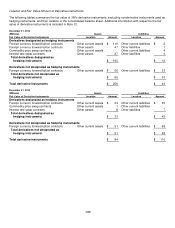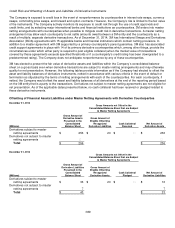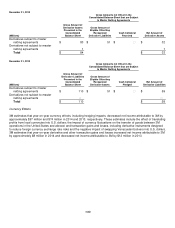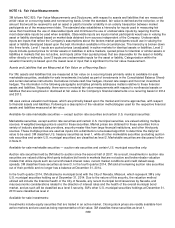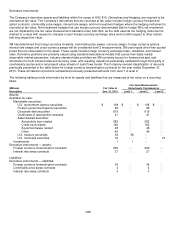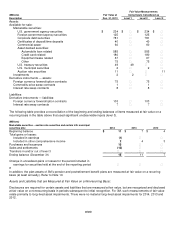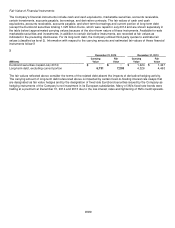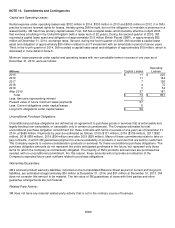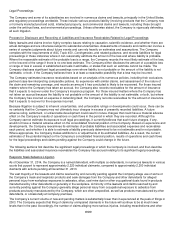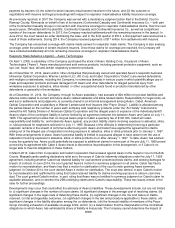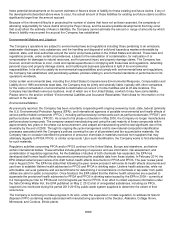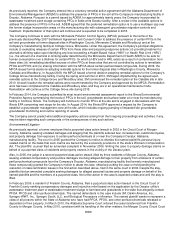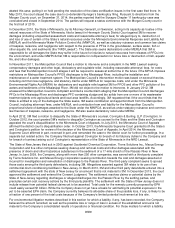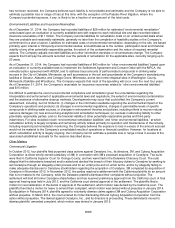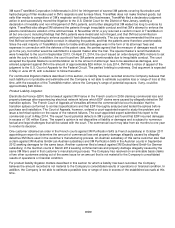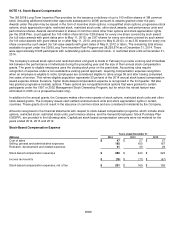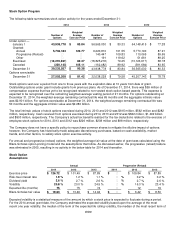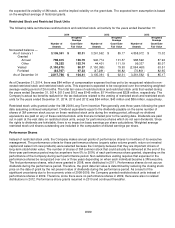3M 2014 Annual Report Download - page 110
Download and view the complete annual report
Please find page 110 of the 2014 3M annual report below. You can navigate through the pages in the report by either clicking on the pages listed below, or by using the keyword search tool below to find specific information within the annual report.104
malignancies, will represent a greater percentage of total claims than in the past. The Company has prevailed in all nine
cases taken to trial, including seven of the eight cases tried to verdict (such trials occurred in 1999, 2000, 2001, 2003, 2004,
and 2007), and an appellate reversal in 2005 of the 2001 jury verdict adverse to the Company. The ninth case, tried in 2009,
was dismissed by the court at the close of plaintiff’s evidence, based on the court’s legal finding that the plaintiff had not
presented sufficient evidence to support a jury verdict.
The Company has demonstrated in these past trial proceedings that its respiratory protection products are effective as
claimed when used in the intended manner and in the intended circumstances. Consequently the Company believes that
claimants are unable to establish that their medical conditions, even if significant, are attributable to the Company’s
respiratory protection products. Nonetheless the Company’s litigation experience indicates that claims of persons with
malignant conditions are costlier to resolve than the claims of unimpaired persons, and it therefore believes the average cost
of resolving pending and future claims on a per-claim basis will continue to be higher than it experienced in prior periods
when the vast majority of claims were asserted by the unimpaired.
As previously reported, the State of West Virginia, through its Attorney General, filed a complaint in 2003 against the
Company and two other manufacturers of respiratory protection products in the Circuit Court of Lincoln County, West Virginia
and amended its complaint in 2005. The amended complaint seeks substantial, but unspecified, compensatory damages
primarily for reimbursement of the costs allegedly incurred by the State for worker’s compensation and healthcare benefits
provided to all workers with occupational pneumoconiosis and unspecified punitive damages. The case has been inactive
since the fourth quarter of 2007, other than a case management conference in March 2011. In November 2013, the State
filed a motion to bifurcate the lawsuit into separate liability and damages proceedings. A hearing on that motion may occur in
the first quarter of 2015. No liability has been recorded for this matter because the Company believes that liability is not
probable and estimable at this time. In addition, the Company is not able to estimate a possible loss or range of loss given
the lack of any meaningful discovery responses by the State of West Virginia, the otherwise minimal activity in this case and
the fact that the complaint asserts claims against two other manufacturers where a defendant’s share of liability may turn on
the law of joint and several liability and by the amount of fault, if any, a jury might allocate to each defendant if the case is
ultimately tried.
Respirator Mask/Asbestos Liabilities and Insurance Receivables: The Company estimates its respirator mask/asbestos
liabilities, including the cost to resolve the claims and defense costs, by examining: (i) the Company’s experience in
resolving claims, (ii) apparent trends, (iii) the apparent quality of claims (e.g., whether the claim has been asserted on
behalf of asymptomatic claimants), (iv) changes in the nature and mix of claims (e.g., the proportion of claims asserting
usage of the Company’s mask or respirator products and alleging exposure to each of asbestos, silica, coal or other
occupational dusts, and claims pleading use of asbestos-containing products allegedly manufactured by the Company),
(v) the number of current claims and a projection of the number of future asbestos and other claims that may be filed
against the Company, (vi) the cost to resolve recently settled claims, and (vii) an estimate of the cost to resolve and
defend against current and future claims.
Developments may occur that could affect the Company’s estimate of its liabilities. These developments include, but are not
limited to, significant changes in (i) the number of future claims, (ii) the average cost of resolving claims, (iii) the legal costs of
defending these claims and in maintaining trial readiness, (iv) changes in the mix and nature of claims received, (v) trial and
appellate outcomes, (vi) changes in the law and procedure applicable to these claims, and (vii) the financial viability of other
co-defendants and insurers.
As a result of the Company’s greater cost of resolving claims of persons who claim more serious injuries, including
mesothelioma and other malignancies, the Company increased its accruals in 2014 for respirator mask/asbestos liabilities by
$62 million. In 2014, the Company made payments for fees and settlements of $49 million related to the respirator
mask/asbestos litigation. As of December 31, 2014, the Company had accruals for respirator mask/asbestos liabilities of
$140 million (excluding Aearo accruals). This accrual represents the low end in a range of loss. The Company cannot
estimate the amount or upper end of the range of amounts by which the liability may exceed the accrual the Company has
established because of the (i) inherent difficulty in projecting the number of claims that have not yet been asserted or the
time period in which future claims may be asserted, (ii) the complaints nearly always assert claims against multiple
defendants where the damages alleged are typically not attributed to individual defendants so that a defendant’s share of
liability may turn on the law of joint and several liability, which can vary by state, (iii) the multiple factors described above that
the Company considers in estimating its liabilities, and (iv) the several possible developments described above that may
occur that could affect the Company’s estimate of liabilities.
As of December 31, 2014, the Company’s receivable for insurance recoveries related to the respirator mask/asbestos
litigation was $41 million. The Company estimates insurance receivables based on an analysis of its policies, including their
exclusions, pertinent case law interpreting comparable policies, its experience with similar claims, and assessment of the
nature of each claim and remaining coverage, and then records an amount it has concluded is likely to be recovered.
Various factors could affect the timing and amount of recovery of this receivable, including (i) delays in or avoidance of



